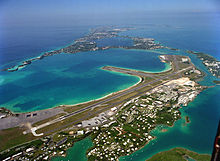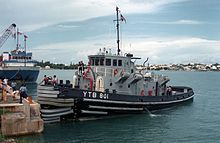- Naval Air Station Bermuda
-
Naval Air Station Bermuda Aerial view of NAS Bermuda, 1993. IATA: BDA – ICAO: TXKF Summary Airport type Military: Naval Air Station Operator United States Navy Location St. David's Island In use 1970 - 1995 Elevation AMSL 12 ft / 4 m Coordinates 32°21′51″N 064°40′43″W / 32.36417°N 64.67861°W Runways Direction Length Surface ft m 12/30 9,898 3,017 Asphalt Naval Air Station Bermuda (Kindley Field), was located on St. David's Island, Bermuda from 1970 to 1995, on the former site of Kindley Air Force Base. It is currently the site of Bermuda International Airport.
Contents
History
The US Navy moved its anti-submarine air-patrol operations to the USAF Base at Kindley Field when its Martin P5M Marlin flying boats were removed from service in the 1960s. They were replaced by Lockheed P-2 Neptune landplanes, which could not operate from the existing Naval Air Station, which had no hard surface runway ashore. The US Navy took over the airfield entirely from the USAF in 1970 and the base continued to operate anti-submarine patrols, first with Neptunes, then with Lockheed P-3 Orions. In the 1980s, the P-3s were occasionally augmented by carrier-based S-3 Vikings operating ashore, as well as Canadian Forces' Lockheed CP-140 Aurora and Royal Air Force Hawker Siddeley Nimrod MR.2 aircraft.
A P-3C from VP-16 returning to NAS Bermuda, 1985.
By the early 1990s, the range of submarine-launched ballistic missiles (SLBM) had so increased that Soviet submarines no longer found it necessary to come within range of Bermuda-based patrol aircraft in order to strike their targets in the USA. This was followed by the dissolution of the Soviet Union in 1991 and a general lessening of tensions between the now renamed Russian Federation and the United States.
Reflecting these developments, the US Naval air detachment at Bermuda had been steadily reduced from a full squadron of Regular Navy P-3Cs on six month rotations to an average of three P-3B or P-3C aircraft, primarily from Atlantic Fleet Navy Reserve P-3 squadrons on 60 day rotations, plus the air station's own UH-1N Twin Huey search and rescue aircraft. In 1992, a scathing investigative report on US television labelled the base as the 'Club Med of the Navy', because of its questionable use by senior military officers and DoD civilian and other U.S. Government civilian officials as a de facto vacation retreat. Subsequently, all three US Naval bases in Bermuda were slated for closure by BRAC. Except for the NASA tracking station on Coopers Island (at the Eastern End of NAS Bermuda), all US facilities in Bermuda were closed in 1995.
The Bermudian government took over operation of the field in 1995, being obliged to spend a great deal of money making it conform to international civil standards. This involved changes to lighting systems, fencing, and razing any objects over a certain height, within a certain distance of the runway (which included both the former base commander's residence, and the hillock it stood on). The US Government still held the lease, which was for 99 years, however, until negotiations were completed regarding the clean up of toxic waste left behind. The cost of clean-up of all US Navy facilities in Bermuda was then estimated at $65.7 million, although that included $9.5 million for replacing the Longbird Bridge. Threats were made that, if the Bermuda government did not allow the US Government to wash its hands of responsibility, the US Navy would take the field over again and close it to all air traffic. The final compromise negotiated by the UK, Bermuda, and USA governments, which comprised an $11 million payment for the replacement of Longbird Bridge, has been denounced by many in Bermuda as a betrayal, but the field has now been transferred entirely to the Bermuda Government as the Bermuda International Airport. It was an alternative landing site for NASA's Space Shuttle.[1]
Areas for clean-up identified in 1997 by a private contractor were:
- Cleaning up petroleum and heavy-metal contamination
- Eliminating friable and non-friable asbestos
- Demolishing derelict and unsafe buildings
- Replacing Longbird Bridge, which they described as unsafe and prone to malfunction
The estimated cost was $65.7 million:
- $11.7 million would be spent on the environmental cleanup.
- $30.9 million would be spent on removing asbestos.
- $8.6 million would be spent on demolition.
- $5.1 million would be spent on managing the work.
- $9.5 million would be spent on replacing Longbird Bridge.
- Naval Air Station Bermuda Annex (Morgans Point, 1941–1995)
- Naval Facility Bermuda (Tudor Hill, 1954–1995)
- Patrol Squadron Bermuda (rotational P-3 squadron while deployed)
- Aircraft Intermediate Maintenance Department Bermuda
- Marine Corps Barracks Bermuda
- USN Submarine Base, Ordnance Island, Bermuda
- Marine Security Force Bermuda
- Naval Medical Clinic Bermuda (formerly USAF Hospital Kindley AFB; formerly Naval Hospital Bermuda)
- Personnel Support Activity Detachment Bermuda
- The Lieutenant Commander Roger B. Chaffee School, a former Department of Defense Dependent School System (DoDDS) facility (Now Clearwater Middle School)
- Anti-Submarine Warfare Operation Center (ASWOC) Bermuda (Ceased Operations and Buildings Removed April 1993)
- Naval Meteorology and Oceanographic Detachment Bermuda
- Navy Exchange Bermuda
Former names
- Fort Bell Army Airfield (1941–1948)
- Kindley Air Force Base (1948–1970)
See also
References
External links
- United Bermuda Party. Copy of Opinion Articles Bases Agreement Most Expensive Mistake in Bermuda’s History, Dr. Grant Gibbons - Opposition Leader (Published on July 10th, 2002 in The Royal Gazette).
- Bermuda Online: American military bases in Bermuda 1941 to 1995.
- The Royal Gazette Scott turns to London on asbestos.
- The Royal Gazette UK tells Bermuda: Asbestos is your problem.
Categories:- United States naval air stations
- Defunct military airports in Bermuda
- Military of Bermuda
- Space Shuttle landing sites
Wikimedia Foundation. 2010.




